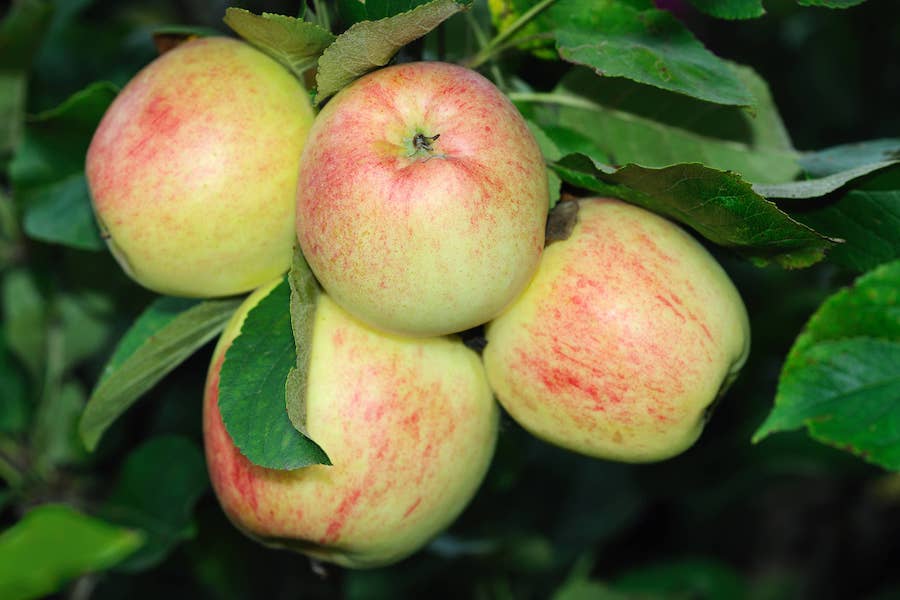Why hasn’t my apple tree produced many fruits?
At the height of apple season, poor crops are always a disappointment
If you’ve had a poor crop of apples this season, there may be some growing tweaks you can make for a better harvest in future years.
Chi Chi Dunford, head kitchen gardener at Sculpture by the Lakes, a botanic garden and outdoor art venue in Dorset, offers the following advice…
What causes apple trees to have a poor crop?

Frost can damage apple blossom
Mainly weather conditions. For example, late frost in April and May will damage the blossoms. Cold or windy weather conditions during blossom season will also prevent pollinators from doing their job.
Some trees over-crop one year, with fewer crops the next. By thinning overcrowded flower buds and fruits, quality can be improved, and you avoid the biennial bearing problem.
Are any apple tree varieties better than others for producing fruit at home?
There are hundreds of varieties of apple trees, so consider several factors when choosing what to grow.
Firstly, decide how you’ll use the fruits and determine whether you want dessert, cooking, or dual-purpose varieties. Also, think about how much time you have to use them. Some can store for a few months, others will only keep for a week or less. It’s best to choose several varieties where picking time is spread out from August to October.

How long do you need to keep your harvest?
Secondly, consider disease resistance. ‘Cox’s Orange Pippin’, for instance, is considered one of England’s greatest apples, but it’s not particularly easy to grow and is prone to different diseases. A good tip is to look for an apple variety which has won the RHS Award of Garden Merit (AGM).
Thirdly, think about your growing space. Apple trees need full sun to grow well. If your space is limited, choose more compact varieties grafted on dwarf rootstock like M27 and M9. If your soil is very poor, you should choose a more vigorous rootstock like M26.
What about pollination?

Pollination plays a part
To ensure good pollination, it is essential to grow two or more different cultivars from the same or adjacent flowering groups. For example, if the variety you choose is group 2, and you will need another variety either in the same group or group 1 or 3.
Dunford recommends the following varieties:
Discovery: Very attractive fruits with bright red skin. Crisp, juicy with a sharp fresh flavour. Picking time in early August.
James Grieve: Perfect for a difficult site. Crops heavily and regularly. The soft texture fruit is both juicy and tangy. It won’t store very well, but is delicious to eat fresh and for baking or juicing. Picking time late August to early September.

‘Red Falstaff’ apple
Egremont Russet: Originating from the Victorian era. It has a unique, nutty flavour and the texture is reminiscent of a firm pear. Picking time late September.
Red Falstaff: Crunchy and juicy straight from the tree, bright red skin with light cream coloured flesh. It is heavy cropping and able to grow well in any garden, as it is self fertile with disease resistance and frost tolerance. Picking time late September.
When’s the best time to plant apple trees?
Pot-grown trees can be planted any time of the year, but as a general rule of thumb, plant between November and February when trees are dormant. Avoid planting when the ground is frozen.
Should I plant them in pots or in the ground?

Apple trees can go straight in the ground
Fruit trees grow best in the ground, but if you can only grow in pots, use a big pot with enough space for roots to grow. Use the best quality potting soil, which is moisture retentive and free draining.
Feed every 10 days during flowering and fruiting months, and make sure the root ball never dries out during summer months.
Pick a sunny spot and avoid waterlogged spots in winter months, as fruit trees resent sitting their roots in waterlogged soil. You should also avoid frost pockets so blossom won’t get damaged by late frost – and note that windy sites will affect pollinators’ activity.
Additional growing tips

Apple trees need a lot of water
1. Keep trees well-watered and mulched. Young trees should have four to five litres of water once a week during warm and dry months, with mulching – compost with around 5cm thickness, or well-rotted manure.
2. Ensure trees aren’t grassed over until they’re established as grass will compete with nutrition and water.
3. In winter, prune out the ‘three Ds’ – dead, damaged, and diseased branches and twigs. You should also remove inward growing and cross rubbing twigs. Basic pruning will aid air circulation and good light to encourage healthy growth.
4. After the ‘June drop’, when apple trees naturally shed fruitlets in early summer, you should thin the trees to just one or two fruits per cluster. Cut away any misshapen, damaged, or scarred fruits until they are evenly spaced, leaving one or two of the best per cluster.
5. Leave around 10-15cm between individual eating apples, and 15-23cm for bigger cooking varieties.
Sculpture by the Lakes is currently hosting an exhibition, ARBOR: A Month of Trees, featuring exclusive artwork, workshops and talks from world famous nature experts. Until October 28.
The Press Association
Latest posts by The Press Association (see all)
- Actor Richard Chamberlain dies aged 90 - March 30, 2025
- 5 new books to read this week - March 26, 2025
- 6 things a physio wishes people over 60 would stop doing - March 25, 2025
- NHS reminder to 7.5m people as Covid-19 jab booking system opens - March 25, 2025
- The truth about cholesterol – what you need to know - March 25, 2025




















